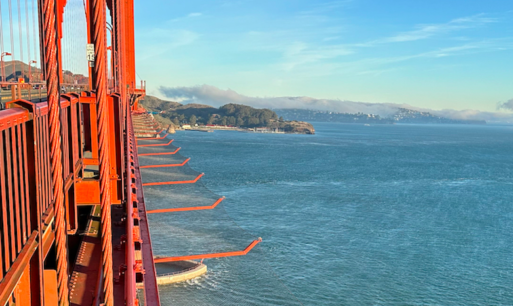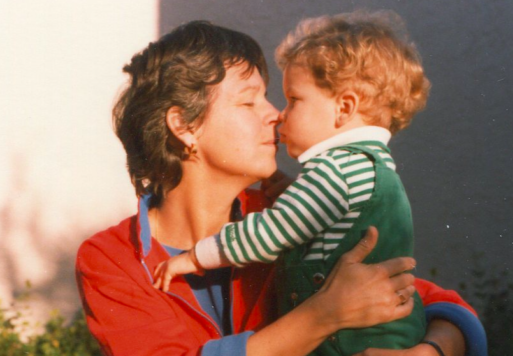
Credit: Golden Gate Bridge Highway & Transportation District
San Francisco’s iconic Golden Gate Bridge has long been recognized for its bright orange towers, elegant cables and Art Deco style. It regularly appears in movies and on television, and draws more than 10 million visitors each year. Yet the bridge’s striking appearance is marred by its more sinister reputation: It has long been a wildly popular destination for suicide jumpers.
Since the Golden Gate Bridge opened in 1937, it has seen roughly 1,800 suicides, according to the Bridge Rail Foundation, which was launched in 2006, by family members of those who’d died, to advocate for a preventative barrier. The bridge’s first casualty was Harold Wobber, a World War I veteran, just months after its opening. Since, there have been thousands of others – a count that doesn’t include those individuals whose bodies were never recovered, or those found in the water but not confirmed to have come from the bridge.
On March 28, 2011, Kay James was in “total shock” to learn that her 28-year-old son, Michael James Bishop, had parked his car, written a note, and jumped from the Golden Gate Bridge to his death. “He was just a very gentle, sweet, kind man,” James said of her son, who played violin in an orchestra and had a warm relationship with his girlfriend. Later that day, Bishop was to start a new job, while transitioning away from his old one.

Kay James with her son, Michael James Bishop, in 1984.
Credit: Courtesy of Kay James
“I think he was doing too much,” James said. “In his note, he just said he couldn’t cope. He was so sorry. He felt like he didn’t belong.” James later joined the Bridge Rail Foundation in advocating for a deterrent, and spoke before the Metropolitan Transportation Commission, which provided the initial funding for the project.
In January 2024, their many years of effort came to fruition. A suicide deterrent system – in the form of a stainless steel net – now spans the full 1.7-mile length of the Golden Gate Bridge, reducing suicides by half even prior to its completion.
Drawn to the Edge
There are more than 48,000 suicide deaths in the U.S. per year. The most common methods of taking one’s life include firearms, hanging or suffocation, and poisoning. Jumping is a less common choice; nevertheless, it’s highly lethal. Jumpers are typically people under 40, including those in the 18-25 age range – a time when people report significantly higher rates of suicide attempts and suicidal thoughts.
Previously, the Golden Gate Bridge averaged 30 suicide deaths a year. According to author John Bateson, these numbers can be attributed to a variety of factors, including: 1) its appealing aura; 2) the mistaken belief that death would be guaranteed and instantaneous; 3) the lack of a gruesome death scene for family members to encounter; and 4) most importantly, easy access. “Every suicide site develops a siren’s call,” said Bateson, who has written several books about suicide, including one called “The Final Leap” about the Golden Gate Bridge. “And the Golden Gate Bridge, just because of its iconic nature, exerts a stronger call than any other source.”

Author John Bateson noted that the Golden Gate Bridge had developed a “siren’s call.”
Credit: Courtesy of John Bateson
While its mystique has led some to suggest that jumpers travel long distances to leap off the Golden Gate Bridge, the truth is less dramatic. The vast majority come from within California; typically, an hour or two away. Still, the ease of access drew at least one woman to fly in from Houston, Texas. “What drew me to it, in spite of having to do so much preparation, is that it is so accessible,” the unnamed individual noted in the 2006 documentary film, “The Bridge.” “You just kind of hop over. But yeah, letting go, that’s the tough part.”

Kevin Berthia has started a foundation to advocate for suicide prevention.
Credit: Courtesy of Kevin Berthia
Kevin Berthia reported a similar draw. Berthia was a 22-year-old father when the depression and suicidal ideation he had long been experiencing came to a head, and he lost hope. On March 11, 2005, he drove himself to the Golden Gate Bridge on an impulse, seeking a foolproof plan. “When I got up there, I saw that there was nothing that was going to deter me,” he said. “I looked over that rail, and saw nothing but the water, and saw that as a sign – you know, this is it.”
Common approaches to prevention at popular suicide locations have included erecting a fence, heightening a railing or installing a safety net – interventions that research has found effective in deterring jumpers, as well as in reducing a locality’s suicides overall. While many bridges choose to raise the height of their railings – the Golden Gate Bridge’s railing is a mere four feet high – others prefer to install a net for aesthetic reasons.
The $244-million suicide deterrent net on the Golden Gate Bridge is set 20 feet down from the railing and 20 feet out over the water; from a distance, it’s largely invisible. Up close, it’s clear that it was designed to be painful, and may even cause injuries. In 2023, while the net was still under construction, its presence halved suicide deaths to 14 for that year. While some people have jumped into the net and been rescued, a smaller number have completed suicide.
Nevertheless, Paolo Cosulich-Schwartz, the director of public affairs at the Golden Gate Bridge Highway and Transportation District, which oversees the bridge, believes these numbers will continue to fall. “The Golden Gate Bridge net will save approximately 30 lives every year for decades to come,” Cosulich-Schwartz said in an email. “The net is a proven design that deters people from jumping, serves as a symbol of care and hope to despondent individuals, and, if necessary, offers people a second chance.”
Why Suicide Barriers Matter
Despite the staggering statistics, Golden Gate Bridge officials didn’t begin to explore the net’s concept until 2008, with construction starting 10 years later. This was largely due to advocacy from the families who’d lost loved ones. “Various mental health professionals spoke to the bridge district board and presented all kinds of reasoned and compassionate arguments for why there should be a barrier on the bridge,” Batson said. “And their arguments were largely ignored. It was only in recent years when family members came forward and started sharing their grief publicly, that the tide turned.” In addition to being an author and former crisis counselor, Bateson is also a board member of the Bridge Rail Foundation – founded by David Hull, who lost his 26-year-old daughter to suicide on the bridge.
In addition, research has continued to challenge the widespread assumption that installing a barrier would simply cause suicidal individuals to turn to other methods of ending their lives. In 1978, Richard Seiden, a former associate professor of behavioral sciences at UC Berkeley, collected data on 515 people who had attempted suicide on the Golden Gate Bridge in its first 34 years, and found that about 90% were still alive. Other, broader studies have reported similar results. “People who are depressed to the point that they want to kill themselves typically focus on one method of doing that; they don’t develop multiple methods,” Bateson said. “So what you’re looking to do is to take that means of suicide away from them, because in all likelihood, they won’t resort to alternative means.”
Wendy Martinez Farmer, the vice president for strategy, grants and clinical standards at the national suicide and crisis lifeline 988, said that the main purpose of a suicide barrier – or any immediate intervention – is to buy time. “We used to think that suicide was not an impulsive act,” she said. “But research on people who’ve actually attempted … has really shed a lot of light on that. A lot of folks will say that thought came up within 5-10 minutes of action, which is a very small period of time. So if you can put a barrier between the thought and the action and get help during that time, it’s really critical.”

Wendy Martinez Farmer, VP of the national suicide and crisis lifeline, 988.
Credit: Courtesy of 988
A phone call is another method of doing so. Signs for the 988 lifeline can often be found on bridges and in parking garages, Martinez Farmer said. She explained that when someone calls the lifeline, they’re given options to speak to experts in veterans’ services, LGBTQIA services, Spanish-language services, or a local crisis center – and not just for suicidal thoughts. “It’s really about mental health or behavioral health related crises, so it could also be a crisis related to substance use,” she said. “The call is an intervention itself.”
Reducing Access to Lethal Means
Awareness of the pivotal significance of access has grown in recent years. The Harvard T.H. Chan School of Public Health has launched a “Means Matter” campaign to raise awareness of the fact that reducing access – whether to jumping from a bridge or to firearms – is a highly effective form of suicide prevention. And in April, the U.S. government released its 2024 National Strategy for Suicide Prevention, which names the third of fifteen goals as “reduce access to lethal means among people at risk of suicide.”
It doesn’t always take much. Bateson shared the story of a 31-year-old housewife who had attempted to jump off the Golden Gate Bridge, but was unable to do so because her skirt was so tight she wasn’t able to step over the rail and was too modest to remove it. For those considering a drug overdose, smaller bottles or blister packages requiring people to remove each pill individually can serve as a similar deterrent by extending that length of time between a thought and an action. “Restricting access to means stops the person at a critical point and helps them to rethink their actions,” noted Jane Pirkis, the Director of the Centre for Mental Health at the University of Melbourne, in an email.
Other popular jump sites, including bridges, have also erected suicide barriers. Many have installed taller railings or fencing, including the Aurora Bridge in Seattle, the Arroyo Seco Bridge in Pasadena, and the Empire State Building in New York – causing suicide deaths to drop dramatically or stop altogether. Others created nets that served as a model for the Golden Gate Bridge’s approach, such as a cathedral in Bern, Switzerland. After a suicide barrier was established at the Bloor Street Viaduct in Toronto, one analysis found that suicides at other bridges increased temporarily. But over the long-term, suicide by jumping decreased without a corresponding increase in suicide by other means.
A human being – typically, a stranger – can also provide that last-minute barrier. Commonly, those who’ve attempted suicide say that in the final moments before they act, they just want to know that someone cares. “I just wanted one person to ask me if I was OK,” said Kevin Hines, one of several dozen people who’ve survived a jump from the Golden Gate Bridge, of his experience on the bridge that day.
Some compassionate volunteers have stepped in to do just that. Inspired by Hines’ story, one woman founded “Bridgewatch Angels,” a group of 100 volunteers that patrolled the bridge for those who might need their presence. Elsewhere, individuals such as Don Ritchie have had their own impact. Ritchie made a habit of inviting potential jumpers on a nearby clifftop into his house outside of Sydney, Australia for some tea and conversation. One article estimated that his intervention had saved hundreds.
For loved ones of somone contemplating suicide, there are approaches that can help. Experts recommend moving beyond checking in with depressed individuals by asking directly if they’re feeling suicidal, and if they have a plan. “The most important thing is to talk about it openly and to be okay about talking about it openly,” Martinez Farmer said. “The worst thing we could do is to make people feel shame associated with talking about suicide.”
For Berthia, it was a compassionate encounter that saved his life: He had already hurled himself into the air when a first responder yelled at him. “It was enough of a distraction to get me out of that dark place I was in,” said Berthia, who grasped the railing at the last moment, landing his feet onto a rope on the other side.
Berthia added that had the deterrent net been in place, he would have gotten that same message and he wouldn’t even have tried. “When people are overwhelmed, in that dark place, they’re looking for easy access,” he said. Looking over the railing, directly at the water, made Berthia feel like his death was meant to be; a net would have suggested otherwise. “It’s saying we love you enough not to make it that accessible and easy for you to take your life,” Berthia said. “Your life matters.”

 Golden Gate Bridge’s Death Count Plummets, Thanks to New Suicide Barrier
Golden Gate Bridge’s Death Count Plummets, Thanks to New Suicide Barrier


 How Dare You Die Now!
How Dare You Die Now!

 “Help Me, Helen”
“Help Me, Helen”














